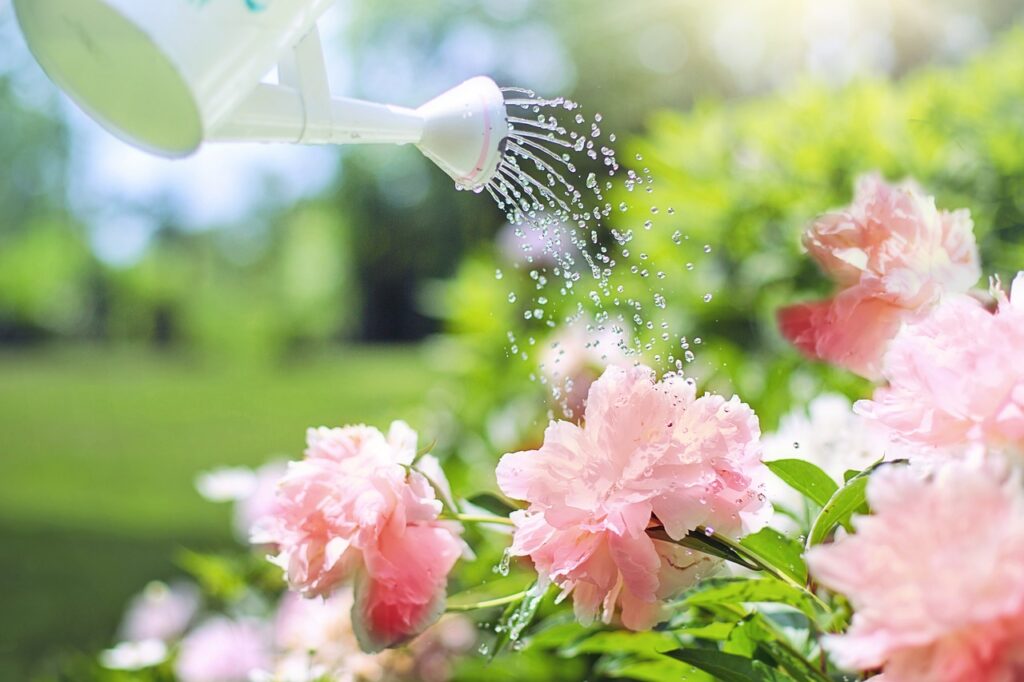- How to Find the Best Garden Pruning Saw: Our Top Picks - January 5, 2024
- Garden Tower Project Review: How To Start Home Gardening ASAP? - January 5, 2024
- Best Garden Scissors Guide: Which Model Suits You Best? - January 5, 2024
Gardening can be a lot of work. For your garden to thrive, there are a lot of tasks that need your attention and watering is one of the most important ones. Making sure that your plants are adequately hydrated keeps them fresh and looking healthy.
A garden watering can is a must-have for any gardener. It allows you to water your plants and flowers with ease while also saving time and energy. Before buying one, there are certain things that you need to consider. Some of them are the size of the pot, the flowerbeds that need watering, the type of watering can i.e., whether made of metal or plastic and so on.
In this post, we will give tips on finding the best garden watering can for your needs.
What to Consider When Choosing a Garden Watering Can
Size and Weight
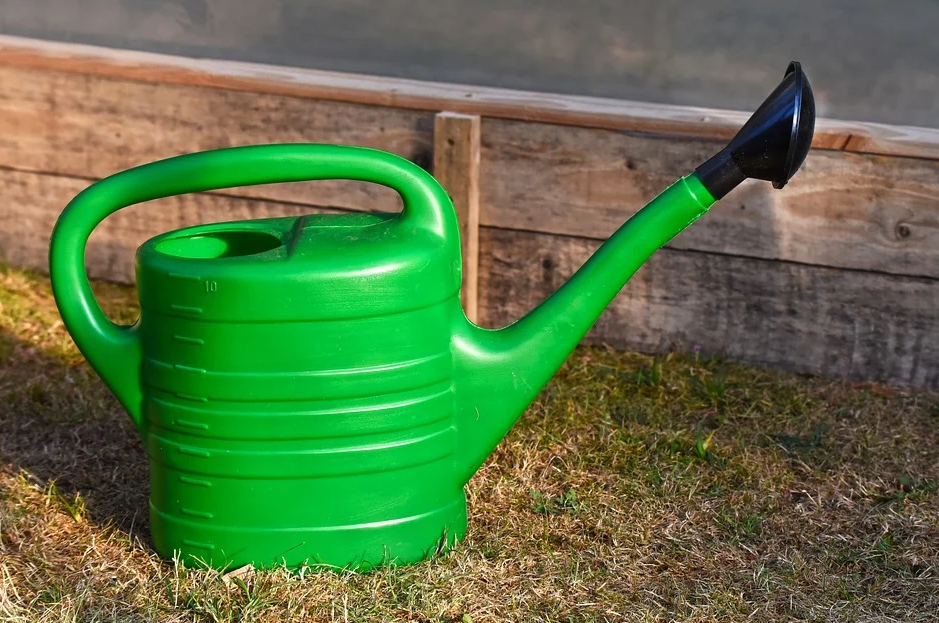
Garden watering cans are made from different materials and come in all shapes and sizes. The size of the watering determines its weight when filled with water. Most watering cans carry between 1- 2.5 gallons of water. The best watering can is one that you can comfortably move around without much strain.
The distance from your garden tap or source of water should be a factor too. Watering a large portion of the garden means that you have to make several trips to the faucet. If you have a large watering can, you will tire from carrying so much weight and from the numerous refill trips. A smaller watering can suffice if the source of water is far from your garden.
Material
Watering cans are either metallic, plastic, or ceramic. Metallic watering cans are some of the most popular and are made from zinc, copper, aluminum, tin, or stainless steel. Metallic cans are usually painted, copper-plated, or galvanized to protect them from harsh environmental conditions.
Plastic and ceramic cans come in all shapes and sizes and are loved for their aesthetic appeal. Unlike metallic watering cans, plastic and ceramic watering cans are not affected by harsh weather conditions.
Spout
The spout is the tube projecting from the watering can, through which water pours onto your garden plants. It is best to consider its length and how water flows from it when it comes to the spout. Some spouts pour while others sprinkle depending on whether it has a rose head or a sprinkler attached to it.
The type of spout you choose will depend on the plants you are watering. For example, when watering seedlings, consider a spout with a gentle flow since the plants are still delicate. You may also opt for a watering can with a longer spout if you water plants planted on a vast seedbed or high-hanging plants for more extended reach.
Handles
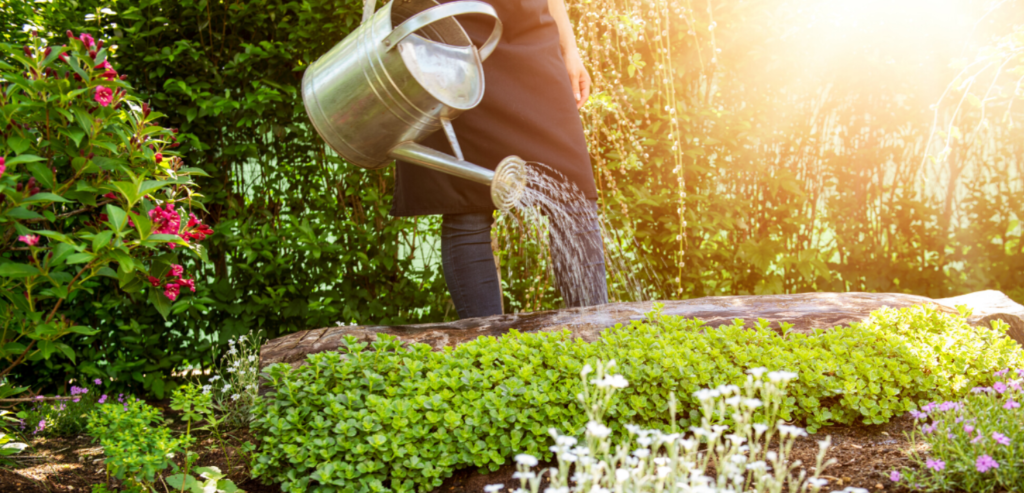
Garden watering cans come with either one or two handles. The size of the watering can help you decide whether to go for a single or double-handled design. For a large watering can, a two-handle design is an ideal choice.
When a large watering can is full of water, having a grip on both handles helps stabilize the can and control the water flow. Being in control of the can helps in minimizing strains on your hands and wrists. Choose a watering can that is easy to handle and work with.
Mouth
Although it doesn’t seem like such a big deal, the mouth of the watering can is an essential factor. Watering cans come with different mouth shapes – narrow or wide, open or covered. If, for example, you are carrying water from a distance, you may opt for a can with a cover to prevent spillage.
A watering can with a narrow mouth also prevents spillage, while one with a wide mouth helps to fill up quickly.
Measurement Marks
Some watering cans come with measurement marks printed on their sides to quantify the amount of water in the can. If you plan to add soluble fertilizers or water-soluble feeds, then this type of watering can is perfect for you. The marks will assist you to use the correct measurements of water to get the suitable concentrations of fertilizers or feeds.
Types of Gardening Watering Cans
Different types of watering cans have unique features. In most cases, the material, body designs, neck or mouth design, length of the spout, and handles are some of the features that distinguish them. Some of the most common watering cans are mentioned below;
Plastic Watering Cans
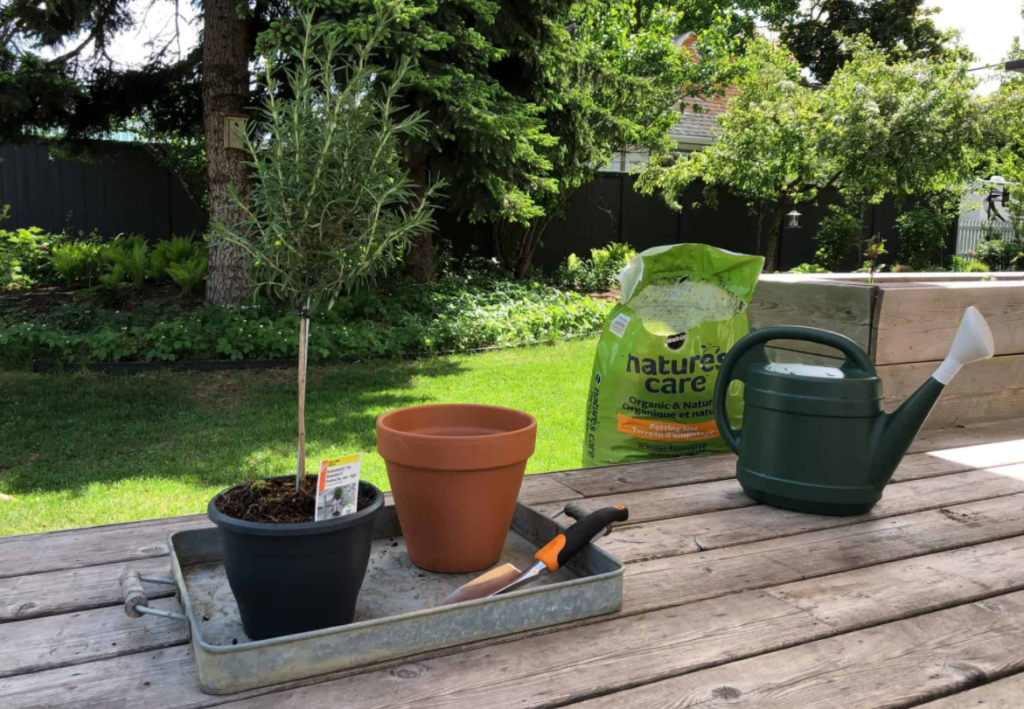
Plastic watering cans are pretty affordable and come in exciting shapes and sizes. They are also sturdy and versatile, making them a popular choice for many people. Since plastic is a lightweight material, these cans are easy to carry around even when filled with water.
Another advantage is that plastic watering cans don’t rust as compared to metal. They can also be stored safely on any surface without leaving scratch marks. However, plastic cans are vulnerable when continually exposed to the sun and may break down with time. But you can choose one made with UV-stabilized plastic material which can withstand the sun’s heat.
Metallic Watering Cans
Most people prefer metallic watering cans because of their longevity and elegant vintage designs. There are different materials types such as copper, tin, aluminum, and zinc used in making them. Painting metallic cans helps protect them from harsh weather conditions, making them last longer.
Due to the material used, they tend to be heavier compared to plastic cans. In addition, these types of cans are susceptible to rust if not painted or stored when dry. Galvanized watering cans are, however, slowly replacing metallic watering cans.
Galvanized Watering Cans
Galvanized watering cans have a great aesthetic appeal as well as a vintage look. Some people place them in their homes as part of the décor. They are made from galvanized steel with a silver coating.
Galvanized cans are strong, last long, and don’t rust easily even when left in the rain. However, they rust if they come into contact with alkaline soil.
Ceramic Watering Cans
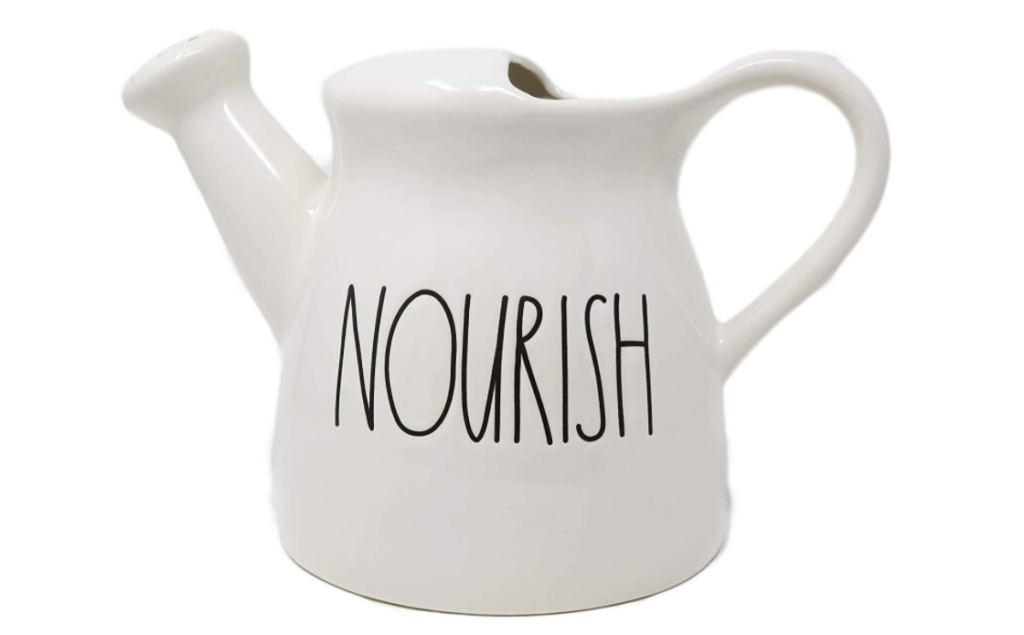
Just like other ceramic household goods, clay is the main ingredient when making ceramic watering cans.. They have spectacular designs with bright colors and intricate shapes. Some people use them as part of their home décor too.
Their great aesthetic appeal makes them ideal for indoor and outdoor gardens. Most of them come in small sizes which tend to hold small volumes of water. Ceramic watering cans require a lot of care. Knocking them against hard surfaces or dropping them will leave them broken.
Since people consider them as pieces of art, ceramic watering cans tend to be more expensive than plastic or galvanized ones.
Long Spouts With Sprinkler Attachment
Some watering cans have long spouts with sprinklers or a rosette attached to their pouring part. Such watering cans come in handy when watering high to reach or hanging plants. They are also effective on plants with broad leaves that prevent the water from reaching the base of the stem.
The sprinkler attachment controls the speed and amount of water pouring from the watering can. They come in different sizes and are adjustable to fit the spout of the watering can. Some rosettes have a fine spray making them suitable for delicate plants such as seedlings or newly planted plants.
Top Five Best Gardening Watering Cans
The watering cans in this guide were chosen based on availability, affordability, and positive customer reviews.
Bloem Watering Can
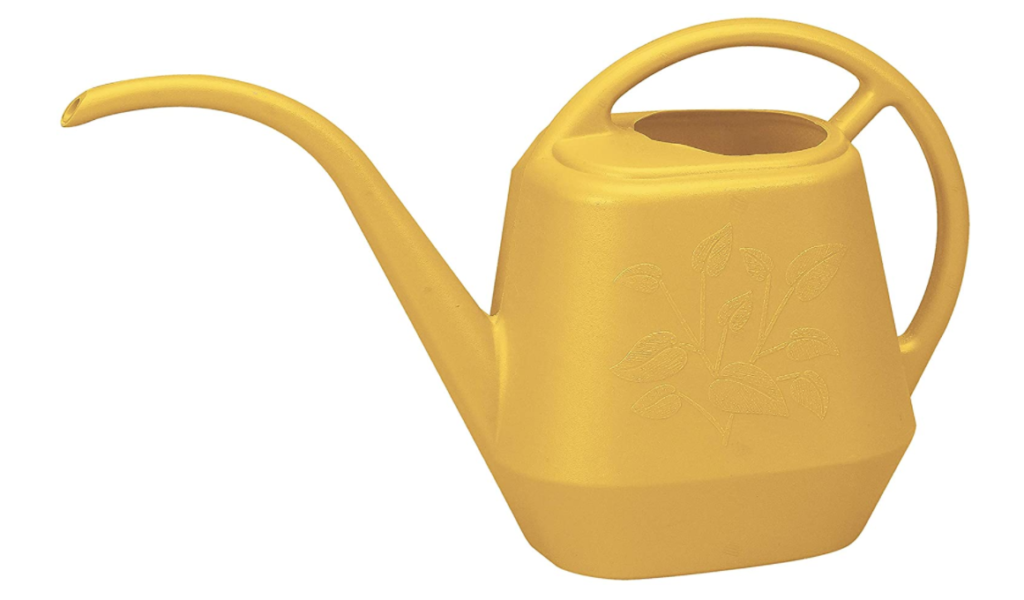
Bloem watering can is a small-sized can with a carrying capacity of 0.5 gallons of water. Being made of plastic as one piece reduces the chances of faults and leakages. The plastic material is UV stabilized, making it strong to withstand the effects of the hot sun, thereby lasting longer. Its long spout and solid and comfortable handles make it perfect for hanging plants.
Pros
- It has a comfortable and easy to use the handle
- Its long spout controls the water flow
Cons
- It is pretty small and therefore unsuitable for watering extensive gardens
- Customers complained of it being smaller than the indicated carrying capacity.
Behrens Watering Can

The Behrens steel watering can is a large metallic can that is perfect for extensive outdoor gardens. It is made from robust and weather-resistant steel, which prevents it from rusting. It comes fitted with a large rose at the end of its spout, which pours a steady amount of water. This ensures that you can cover large areas in a short time.
It has a classic, vintage look with an elegant finish. The solid and comfortable handle makes it easy to carry around when working.
Pros
- Made of sturdy steel, which makes it last longer without rusting
- Holds a large volume of water, minimizing trips for a refill
- Quite affordable
Cons
- It has a non-removable rose which may be an inconvenience to some people
- When full, it can be quite heavy to move around
Union Watering Can With Tulip Model
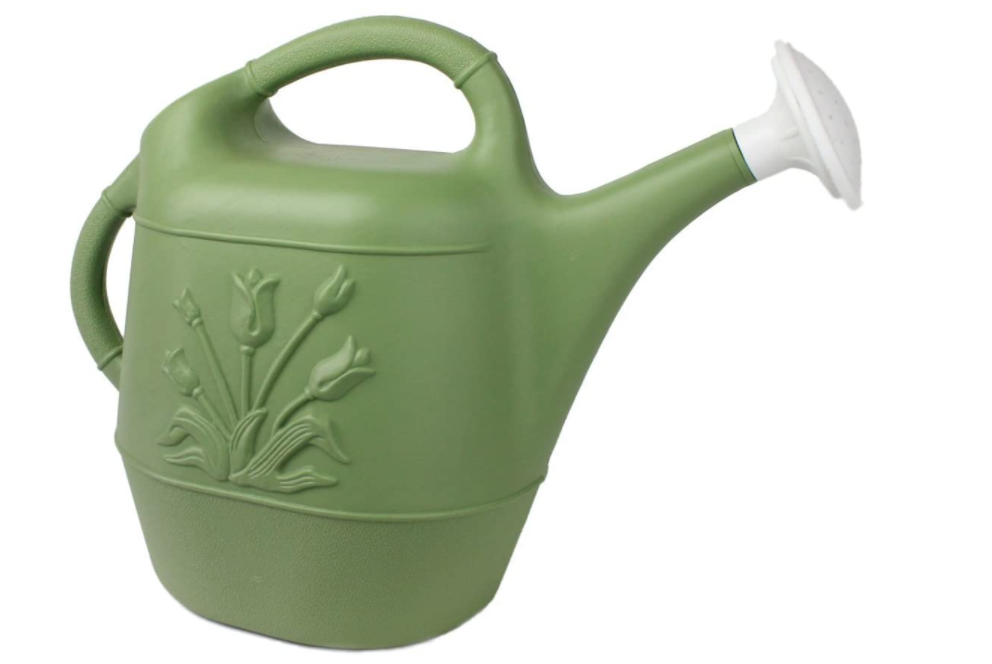
The union watering can comes in two models with different capacities – one and two-gallon sizes. It has a short spout with a wide enough rose which ensures that your plants get adequate water.
It is available in four different colors and is available at an affordable price. The 2-gallon version is relatively lightweight, making it easy to carry a large amount of water at once. Its sprinkler head or rose is removable. So you have a choice of either watering your plants in a shower or just pouring directly from the spout.
Pros
- Quite affordable
- It has a replaceable rose head
Cons
- It has a short spout which may make it hard to water broad flower beds.
- It may deteriorate with time because of its less durable method of making plastics – the blow mold method.
Rainmaker Watering Can
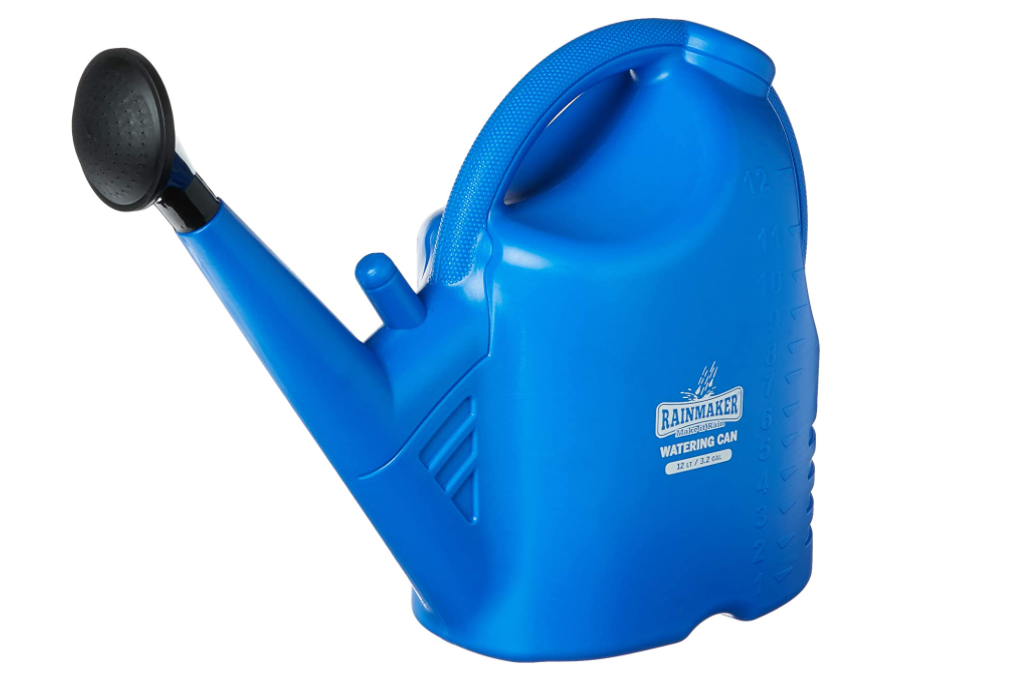
The rainmaker watering can is made of heavy-duty plastic, making it strong enough to withstand wear and tear for several years. It has a huge carrying capacity and can hold up to 3.2 gallons or 12 liters of water.
Despite its considerable size, it is quite light and well-balanced, which means that you don’t have to struggle to carry it around or make many trips to refill. It comes with a detachable rose which makes it easy to clean the rose and the spout. The rose gives it a fine and even spray, which spreads quickly on your garden.
Pros
- It has a big capacity making it an ideal watering can for extensive gardens
- Made from heavy-duty material making it last for a long time
Cons
- It may be unsuitable for small-bodied people due to its huge carrying capacity
- The opening on the top is small, making it a challenge to fill up or see water levels
Cesun Metal Watering Can
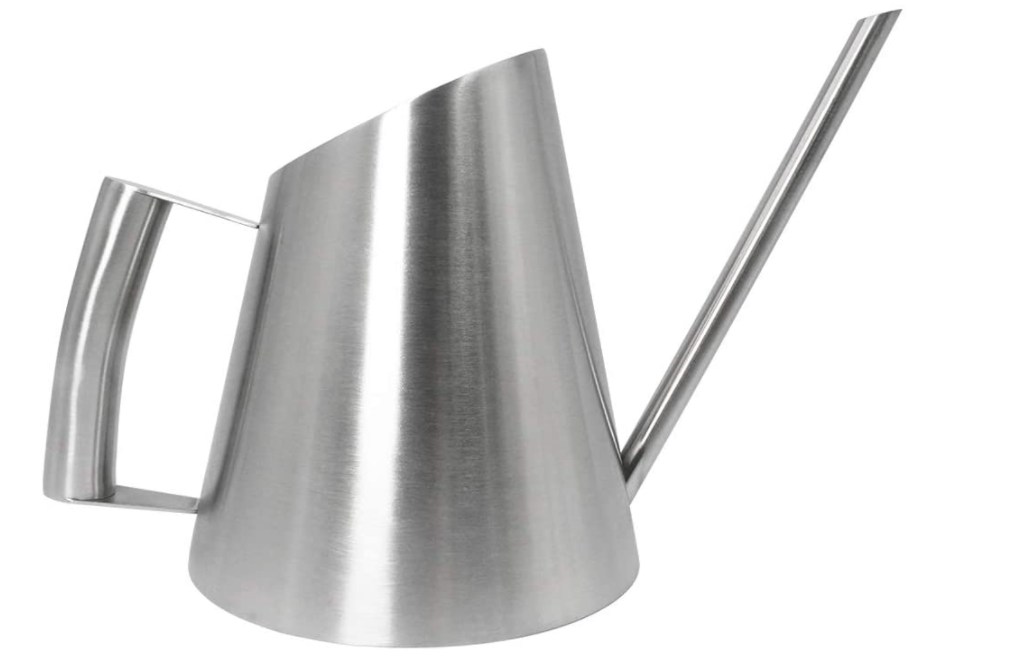
The Cesun metal watering can is a double-handled can made of galvanized steel. It has a carrying capacity of one gallon of water. It comes with a removable spray spout and a movable upper handle. Its vintage style look presents a nice mix of practicality and aesthetic feeling.
Due to its small capacity, you can carry it around with ease. Cesun watering cans undergo thorough testing to prevent leakages. So you can be sure that you are getting a quality product should you decide to buy.
Pros
- It has a detached rose, making it convenient to choose between spraying water or a more robust and steady stream
- It has a movable upper handle, making it easy to tilt the can in the desired watering angles.
Cons
- It might be unpopular with people with extensive gardens because of forcing them to make more refill trips due to its small capacity.
- Some previous customers complained of leakages on the spout.
FAQs
Answer: Watering cans are essential especially where you can’t use a horse pipe for example on rooftop gardens. You can also control the flow of water from watering cans, unlike from horse pipes, which you have to control from the faucet.
Answer: Choosing between the two depends on your preferences. Plastic cans are lightweight and do not rust. They are also less expensive. Metallic cans are heavier and costlier. Galvanized steel, aluminum metal, and stainless steel don’t rust
Answer: Most watering cans hold between 0.5 liters to 10 liters. Watering cans used indoors tend to have a smaller capacity compared to those used outdoors.
Conclusion
Choosing a watering can doesn’t have to be that difficult. First, you need to consider its size and weight when filled with water. Go for one that you can carry around comfortably without much strain. If you prefer metallic watering cans, go for galvanized or copper plated ones that are not prone to rust and are not affected by harsh weather conditions.
Similarly, if you like plastic cans more, buy one made from UV stabilized materials as they last longer. Cans with double handles are also more stable as compared to single-handled ones. With the correct watering can, you will be able to keep your garden flourishing while taking care of the seedlings, flowers, and other plants.

